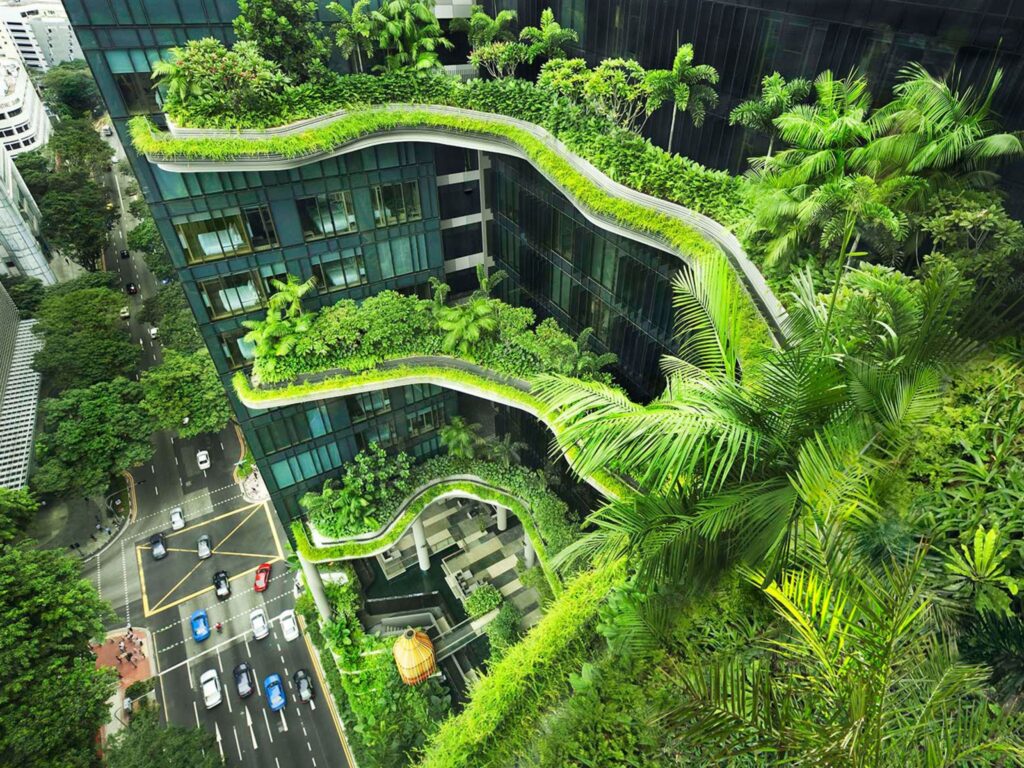Biophilic architecture is a design philosophy that integrates the natural world into the built environment. Rooted in the concept of biophilia—a term popularised by biologist Edward O. Wilson, which refers to humans’ innate connection to nature—this architectural approach seeks to improve well-being, enhance creativity, and promote sustainability by blending organic elements with modern living spaces.

The Essence of Biophilic Design
Biophilic architecture goes beyond simply incorporating plants or greenery into a space. It involves the thoughtful integration of natural elements, patterns, and principles into the core design of a building. This approach often includes features like:
- Natural Light: Maximising daylight through expansive windows, skylights, and open layouts.
- Green Spaces: incorporating indoor gardens, vertical walls, and rooftop greenery.
- Organic Materials: Using wood, stone, and other natural materials to create warmth and authenticity.
- Water Features: Adding fountains, ponds, or aquariums to introduce soothing auditory and visual elements.
- Views of Nature: Ensuring occupants have access to outdoor views, enhancing their connection to the environment.
By creating spaces that mimic natural environments, biophilic architecture enhances the sensory experience, making it more engaging and restorative.
Benefits of Biophilic Architecture
The growing interest in biophilic design stems from its numerous benefits, which positively impact individuals, communities, and the planet.
- Enhanced Well-being: Studies have shown that exposure to natural elements reduces stress, improves mood, and boosts overall health. Biophilic spaces promote relaxation and productivity, making them ideal for workplaces and homes.
- Increased Sustainability: By incorporating energy-efficient designs and green spaces, biophilic architecture minimizes environmental impact. Features like green roofs improve insulation, reduce heat absorption, and promote biodiversity in urban areas.
- Improved Air Quality: Integrating plants and natural ventilation systems enhances indoor air quality, benefiting occupants’ respiratory health.
- Economic Value: Properties designed with biophilic principles often command higher market value due to their appeal and functionality. Businesses in biophilic buildings report increased employee satisfaction and retention.
Examples of Biophilic Architecture
Around the world, architects and urban planners embrace biophilic principles to redefine modern living spaces.
- The Bosco Verticale (Milan, Italy): This iconic pair of residential towers features over 900 trees and thousands of shrubs, creating a vertical forest that improves air quality and provides a stunning visual impact.
- Changi Airport (Singapore): Known for its lush indoor gardens and a giant waterfall, the airport blends biophilic elements to create a calming, immersive experience for travellers.
- Amazon Spheres (Seattle, USA): Housing over 40,000 plants, these interconnected glass domes serve as a workplace and urban oasis for Amazon employees, demonstrating how biophilic design can redefine office spaces.
Implementing Biophilic Principles in Everyday Spaces
Biophilic architecture isn’t just for large-scale projects; it can be applied to smaller homes and offices as well. Here are a few ways to bring biophilic elements into everyday environments:
- Use of Plants: Introduce indoor plants or green walls to add life and colour.
- Natural Materials: Opt for furniture and decor made of wood, bamboo, or stone.
- Lighting Design: Replace artificial lighting with daylight-mimicking options.
- Connection to Outdoors: Create outdoor living spaces like patios or balconies.
- Sensory Elements: Incorporate elements like water features or aromatic plants to engage the senses.
Challenges in Biophilic Design
Despite its benefits, biophilic architecture comes with its own set of challenges:
- Cost: Initial investments in green roofs, advanced lighting, and sustainable materials can be high.
- Maintenance: Living walls and green spaces require regular care to thrive.
- Urban Constraints: In dense cities, integrating nature into the built environment may require creative solutions to overcome space limitations.
However, advancements in technology and growing awareness about sustainable practices are gradually making biophilic design more accessible.
The Future of Biophilic Architecture
As cities continue to grow, the need for sustainable and health-promoting spaces is becoming increasingly urgent. Biophilic architecture offers a viable solution by harmonizing urban development with nature. Governments and organizations worldwide encourage green building certifications, such as LEED (Leadership in Energy and Environmental Design), aligning with biophilic principles.
Moreover, biophilic architecture is not just a trend but a shift in how we approach urban design. By prioritising human health, environmental sustainability, and aesthetic beauty, this architectural philosophy has the potential to transform the way we live, work, and interact with our surroundings.

